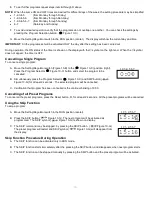
Some Points to Remember
•
Learn to recognize the odour of LP Gas.
Your local LP Gas dealer can give you a "Scratch and Sniff" pamphlet. Use it to
find out what the propane odour smells like. If you suspect that your LP Gas has a weak or abnormal odour, call your LP
Gas dealer.
•
If you are not qualified, do not light pilot lights, perform service, or make adjustments to appliances on the LP Gas system.
If you are qualified, consciously think about the odour of LP Gas prior to and while lighting pilot lights or performing service
or making adjustments.
•
Sometimes a basement or a closed-up house has a musty smell that can cover up the LP Gas odour. Do not try to light
pilot lights, perform service or make adjustments in an area where the conditions are such that you may not detect the
odour if there has been a leak of LP Gas.
•
Odour fade, due to oxidation by rust or absorption on walls of new cylinders and tanks, is possible. Therefore, people
should be particularly alert and careful when new tanks or cylinders are placed in service. Odour fade can occur in new
tanks or reinstalled old tanks if they are filled and allowed to set too long before refilling. Cylinders and tanks which have
been out of service for a time may develop internal rust which will cause odour fade. If such conditions are suspected to
exist, a periodic sniff test of the gas is advisable.
If you have any question about the gas odour, call your LP Gas
dealer. A periodic sniff test of the LP Gas is a good safety measure under any condition.
•
If, at any time, you do not smell the LP Gas odorant, and you should, assume you have a leak. Then take the same
immediate action recommended when you do smell the odorized LP Gas.
•
If you experience a complete "gas out" (the container is under no vapour pressure), turn the tank valve off immediately.
If the container valve is left on, the container may draw in some air through openings such as pilot light orifices.
If this occurs, some new internal rusting could occur. If the valve is left open, then treat the container as a new tank.
Always be sure your container is under vapour pressure by turning it off at the container before it goes completely empty or
having it refilled before it is completely empty.
Technical Data
OUTPUT HEATING CAPACITY
kW
3.96
M
A
N
IF
O
L
D
P
R
E
S
S
U
R
E
MAX
NATURAL
GAS
mbar
7.7
kBTU/hr.
13,500
in
W.C.
3.1
INPUT RATING
kW
5.19
LP
mbar
26.4
kBTU/hr.
17,700
in
W.C.
10.6
MINIMUM INPUT RATING
(LO Input)
kW
3.84
MIN
NATURAL
GAS
mbar
4.6
kBTU/hr.
13,100
in
W.C.
1.8
THERMAL EFFICENCY
%
76.27
LP
mbar
16.3
LENGTH
mm
553
in
W.C.
6.6
in
21-3/4
G
A
S
R
A
T
E
MAX
NATURAL
GAS
m
3
/h
0.5
HEIGHT
mm
715
ft
3
/h
17.8
in
28-1/8
LP
m
3
/h
0.2
DEPTH
mm
208
ft
3
/h
6.9
in
8-1/4
MIN
NATURAL
GAS
m
3
/h
0.4
WEIGHT
kg
26
ft
3
/h
13.3
lbs.
57
LP
m
3
/h
0.1
GAS CONNECTION
NPT
3/8
FEMALE
ft
3
/h
5.3
WALL HOLE DIAMETER
mm
50
MINIMUM INLET
PRESSURE
NATURAL
GAS
mbar
17.4
in
2
in
W.C.
7.0
AIR INLET DIAMETER
mm
49
LP
mbar
27.4
in
1-7/8
in
W.C.
11.0
EXHAUST PIPE DIAMETER
mm
35
AIR FLOW
m
3
/h
220
in
1-3/8
cfm
129
MAX WALL THICKNESS
mm
150
MINIMUM AIR FLOW
m
3
/h
160
in
5-7/8
cfm
94
MIN WALL THICKNESS
mm
500
TOTAL ELECTRICAL LOAD
W
86
in
19-5/8
4





































